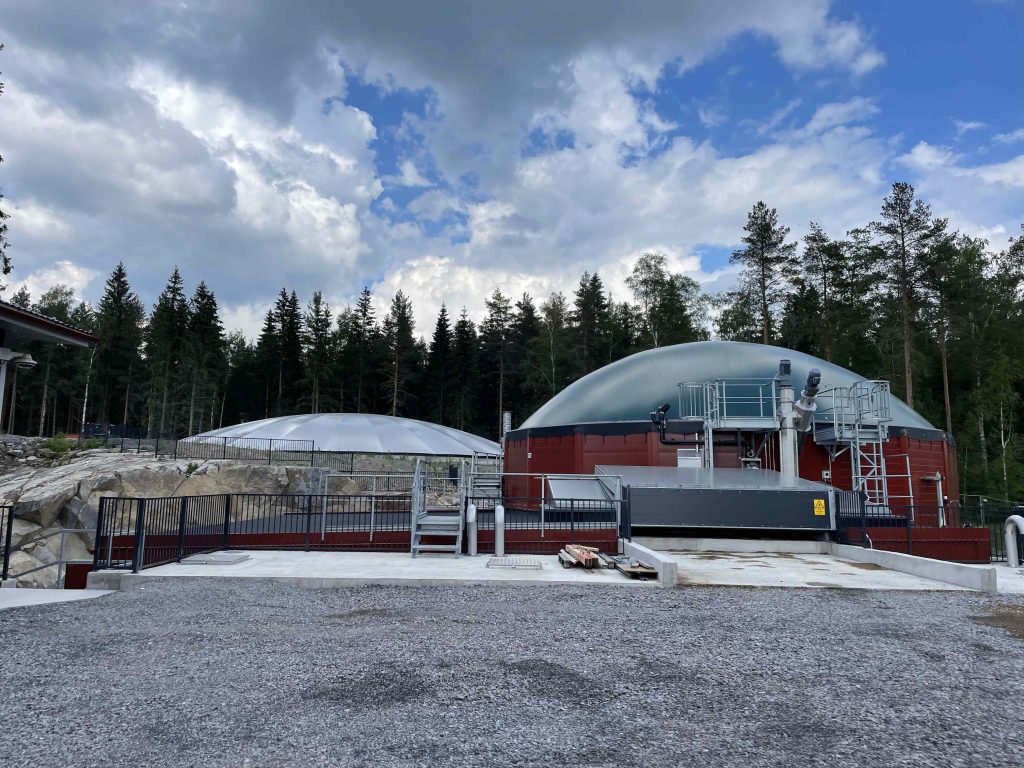Biogas is a versatile form of energy, as it is used in heat and electricity production and can be refined into biomethane for fuel. Using biogas reduces dependence on fossil fuels and lowers greenhouse gas emissions. Additionally, the process produces a nutrient-rich digestate as a byproduct, which can be used as fertilizer in its raw form or further processed into recycled fertilizer.
Biogas is generated through anaerobic digestion, a biological decomposition process that occurs naturally in oxygen-free conditions. In biogas plants, biogas is produced by digesting organic matter such as manure, crop biomass, or biowaste. Biogas is a gas mixture primarily composed of methane (50–70%) and carbon dioxide (30–50%). The composition of the gas depends on the digested biomass (feedstock) and the digestion process.

Luke’s biogas plant in Jokioinen.
Benefits of biogas production for farms:
- Improves energy self-sufficiency and circular cycles: Biogas can be used on farms for electricity and heat production or refined into transportation fuel for sale, reducing reliance on external energy sources and potentially generating additional income.
- Reduces fertilizer purchases: Utilizing digestate reduces the need for mineral fertilizers, leading to lower fertilizer costs.
- Enhances nutrient utilization: The digestion process increases the soluble nitrogen content, improving the fertilizer value compared to raw manure.
Situation in Finland
Finland produces approximately 1 TWh of biogas annually, despite having a production potential of up to 10 TWh per year. In 2025, Finland will have 97 biogas plants, including farm-scale plants, industrial and municipal waste-based plants, and sludge digesters (Finnish Biocycle and Biogas Association, 2025). Additionally, 36 new plant projects are in the planning or construction phase between 2025–2027.
Farms play a crucial role in biogas production due to the large volumes of agricultural side streams generated annually. Manure has the highest potential, with approximately 17 million tons produced yearly.
The number of farm-specific biogas plants has been growing in recent years. In 2025, Finland had 46 farm-based biogas plants, mainly using manure as feedstock. These plants are located in regions with readily available biomass, such as Satakunta and Ostrobothnia. South Ostrobothnia also has significant potential for biogas production due to its concentration of livestock farms (Bioenergia 2025).
Biogas plant profitability
The profitability of a biogas plant depends on various factors, and political decisions and regulations significantly impact biogas investments and project success. Investment in biogas is hindered by complex and fragmented regulations, political uncertainty, and unpredictable subsidy changes. Bureaucracy and slow permitting processes make project initiation difficult. For farmers, uncertainty and CAP-related bureaucracy reduce their willingness to invest.
For example, the Luke’s Biogas tool can provide an initial estimate of a biogas plant’s profitability.
At its best, a successful biogas plant strengthens regional self-sufficiency by utilizing local side streams and efficiently recycling their nutrients, thereby improving farm profitability.
Biogas production side streams can be offered or searched for easily through the KiertoaSuomesta.fi marketplace. After logging into the platform, users can explore the map feature to check the availability of biobased side streams in their area. The marketplace connects material producers and users, supporting resource-efficient operations, nutrient recycling, and the formation of new partnerships.
References
Bioenergia-lehti, 2025: Biokaasun tuotanto voidaan moninkertaistaa Pohjalaismaakunnissa
Motiva: Biokaasu
ProAgria: Maatilojen biokaasu – liiketoimintamallien tarkastelua
Suomen Biokierto ja Biokaasu ry, 2025: Tiedote Suomen biokaasulaitosinvestoinneista ja Biokaasu ja maatilat